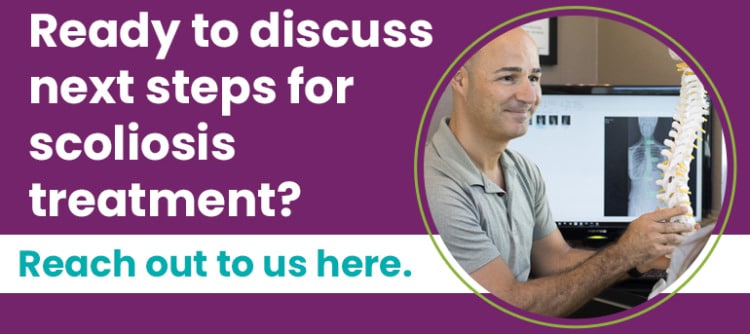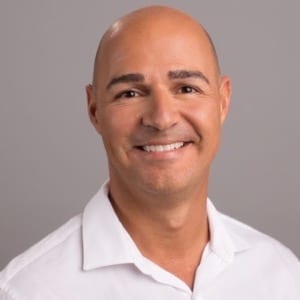Why Exercise Is Crucial for Scoliosis Management
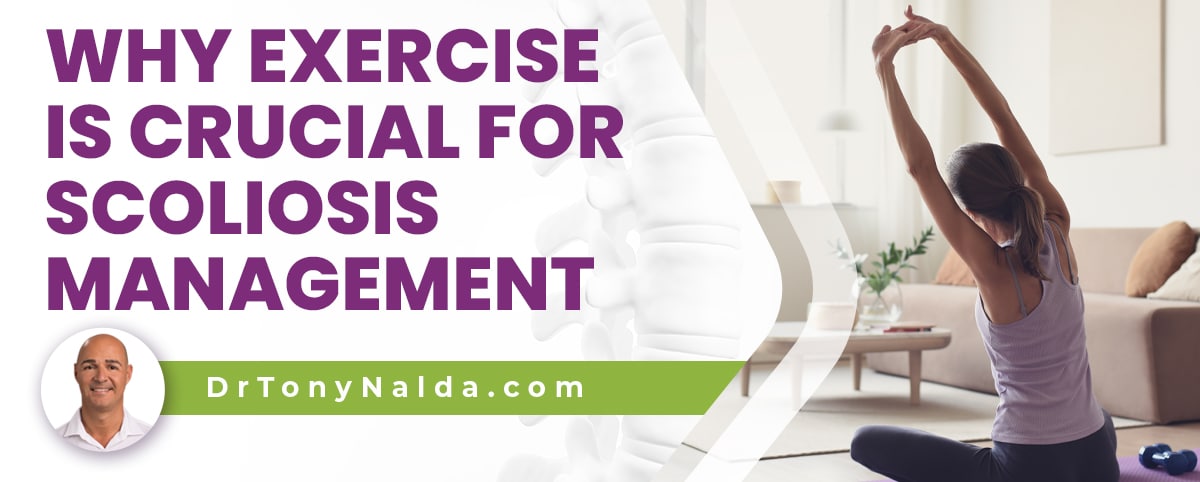
/When it comes to managing scoliosis, this involves leading a scoliosis and spine-friendly lifestyle, and exercises designed to facilitate this are key. When scoliosis-specific, exercise can help counteract spinal rigidity and strengthen the spine's surrounding muscles for optional support and stability.
The place of exercise in scoliosis management was once questioned, and there are now entire exercise-based treatment programs that have developed. When combined with other forms of corrective treatment, exercise can help maintain spinal flexibility, improve muscle balance, strength, and posture.
Scoliosis exercises are important for spinal health and flexibility, pain management, and strength training.
Table of Contents
Exercising with Scoliosis
There was a time when being diagnosed with scoliosis was thought to mean a life of limitations, but the number of professional athletes and celebrities who have fulfilled life-long ambitions, despite being diagnosed with scoliosis, prove otherwise.
A healthy lifestyle is important for everyone, and this means a healthy activity level, and for people with scoliosis, staying active is particularly important.
Maintaining a healthy weight and activity level means less pressure on the spine; it also means strong core muscle for better spinal support.
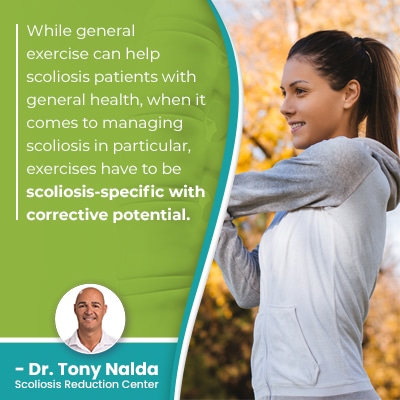 While general exercise can help scoliosis patients with general health, when it comes to managing scoliosis in particular, exercises have to be scoliosis-specific with corrective potential.
While general exercise can help scoliosis patients with general health, when it comes to managing scoliosis in particular, exercises have to be scoliosis-specific with corrective potential.
So why is exercising particularly important for scoliosis? The answer has different parts, so let's address each area affected by scoliosis exercises: pain management, spinal flexibility, muscle imbalances and strength training.
Exercises for Scoliosis Pain Management
Not everyone with scoliosis will experience pain; in fact, although children are more commonly diagnosed with scoliosis, pain isn't considered a common symptom of childhood scoliosis.
Scoliosis commonly becomes painful once it becomes a compressive condition, and this occurs when skeletal maturity is reached.
In young patients who are still growing, the constant lengthening motion of growth counteracts the compressive force of the unnatural sideways spinal curve, and it's compression of the spine and its surrounding muscles and nerves that causes the majority of condition-related pain.
Pain is the main symptom of adult scoliosis, and as scoliosis is a progressive condition that causes the spine to become increasingly rigid, exercise that maintains spinal flexibility can help counteract compressive back pain.
Exercise can also help with pain management by strength training: a spine with strong surrounding muscles is one that doesn't have to work as hard to maintain its curves and alignment.
Regular stretches for scoliosis can help keep the spine as loose as possible, making it more responsive to treatment and less painful.
Exercises for Spinal Flexibility
As mentioned above, scoliosis is a progressive condition that's triggered by growth, which is why childhood scoliosis should always be taken seriously and treated proactively.
As scoliosis progresses, the spine's unnatural bend and twist is increasing, and this makes the spine more rigid and less responsive to treatment; smaller curves are easier to correct than moderate, severe, and very severe cases.
Exercises can be specifically designed with the goal of counteracting spinal rigidity, making the spine more responsive to treatment and less painful because it's less stiff.
A spine that's loose and flexible has a wide range of motion and staying active is key for the spine's movement-based design.
When a significant amount of progression has already occurred before treatment has been started, as is often the case with my adult scoliosis patients, exercise has to be used to first establish a baseline level of spinal flexibility before the regular treatment plan can be started.
Exercising for Muscle Balance and Strength
Exercise can be used to counteract some condition effects, one of which is a muscular imbalance caused by the condition's uneven forces disrupting the body's overall symmetry.
The main symptom of scoliosis in children involves postural deviation such as uneven shoulders, shoulder blades, and uneven hips.
In addition to disrupting the body's postural balance, the spine's surrounding muscles can also be affected.
A muscle imbalance is a common effect as the spine's surrounding muscles are pulled in different directions; the muscles on one side of the spine can become stretched and sore from overuse while the muscles on the other side can become weak from lack of use.
A key facet of scoliosis treatment focuses on how the condition is affecting the spine's surrounding muscles; a spine that's surrounded by unbalanced and/or weak muscles will be less able to maintain healthy curves and alignment.
Exercise can be targeted to balance the spine's surrounding muscles, and strength training can help improve the spine's support and stability.
Using exercise to strengthen the spine's surrounding muscles is a safe and non-invasive means of improving the spine's position and support.
Exercise as Part of Conservative Scoliosis Treatment
Here at the Scoliosis Reduction Center®, a conservative treatment plan combines the power of multiple scoliosis-specific treatment disciplines for an innovative and integrative approach.
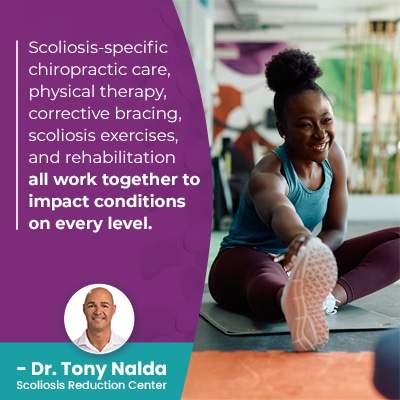 Scoliosis-specific chiropractic care, physical therapy, corrective bracing, scoliosis exercises, and rehabilitation all work together to impact conditions on every level.
Scoliosis-specific chiropractic care, physical therapy, corrective bracing, scoliosis exercises, and rehabilitation all work together to impact conditions on every level.
Conservative treatment is chiropractic-centered; as a structural spinal condition, scoliosis has to be impacted on a structural level.
Conservative Treatment Options
Chiropractic care and manual adjustments can work towards repositioning the curve's most-tilted vertebrae back into alignment with the rest of the spine, and this type of adjustment reduces the curve size and restores as much of the spine's healthy curves as possible.
But structural changes on a structural level need to be supported by its surrounding muscles, where exercise as part of treatment comes into play.
A scoliosis physical therapist can help counteract the condition's effects to restore muscle balance and symmetry, which in turn restores the spine's balance and stability for corrective potential.
Exercise can be used for increasing spinal flexibility, pain management, muscle balance and strengthening, and when scoliosis-specific and combined with chiropractic care, physical therapy, corrective bracing, and rehabilitation, it can help impact scoliosis on every level.
It is important, however, that patients don't attempt any exercise, sport, or activity that's not approved by their treatment provider as scoliosis makes the spine more vulnerable to injury and strain.
Exercises and Activities to Avoid with Scoliosis
Exercise and activity restrictions/recommendations will be case-specific, but in general, those that involve overusing one side of the body, repeated jarring motions, and placing the spine in unnatural positions should be avoided.
Some activities can be deemed safe for people with scoliosis, while others will need to be modified, and/or avoided completely.
Activities that overuse one side of the body can exacerbate the condition's asymmetrical effects, such as a muscular imbalance; bowling, tennis, and golf aren't commonly recommended exercises.
Activities and exercise that involve repeated shock from impact expose the spine to compression, and as scoliosis becomes compressive once growth has stopped, it's already being weakened by uneven pressure.
Collision sports that involve stress from repeated impact and or repeated jarring motion can further weaken an already-vulnerable spine, so horseback riding, football, and martial arts aren't recommended.
A scoliotic spine is already bent and twisted unnaturally, and its misalignment can be felt throughout the body, so activities and exercises that place the spine in unnatural positions, such as hyperextensions used in gymnastics, diving, and certain dance styles, can further disrupt the spine's alignment and increase the spine's rotation.
Conclusion
Why should you do exercises for scoliosis? Because they can help with scoliosis pain, increasing spinal flexibility, and restoring muscle symmetry and strength for better spinal support.
When scoliosis specific and integrated into a proactive treatment plan, scoliosis exercise can make the spine more responsive to treatment, prevent progression, and reduce curve size for corrective results.
Exercise-based treatment approaches such as the Schroth method and SEAS have earned a place in scoliosis treatment with proven results and as a valuable facet of conservative non-surgical scoliosis treatment.
Here at the Center, patients start treatment immediately following a diagnosis, and scoliosis specific exercises are part of a conservative treatment plan.
Exercises such as pelvic tilts and the plank exercise can help increase mobility and improve core strength, and schroth exercises can help with postural remodeling and awareness.
While traditional scoliosis treatment focuses on just the spine, conservative treatment wants to address all condition effects felt throughout the body.
It's important for everyone to practice good posture; this is best for the spine's biomechanics. For people with scoliosis, a focus of treatment is on how to improve posture so the spine is held in a straighter alignment.
The complex nature of scoliosis necessitates a customized treatment plan, including exercises customized for 3-dimensional correction of a specific curvature type, location., and severity.
Dr. Tony Nalda
DOCTOR OF CHIROPRACTIC
After receiving an undergraduate degree in psychology and his Doctorate of Chiropractic from Life University, Dr. Nalda settled in Celebration, Florida and proceeded to build one of Central Florida’s most successful chiropractic clinics.
His experience with patients suffering from scoliosis, and the confusion and frustration they faced, led him to seek a specialty in scoliosis care. In 2006 he completed his Intensive Care Certification from CLEAR Institute, a leading scoliosis educational and certification center.
About Dr. Tony Nalda
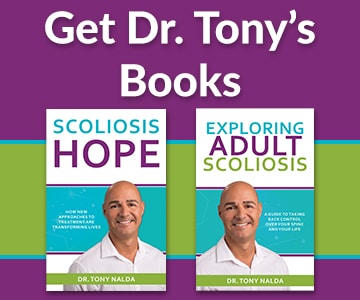 Ready to explore scoliosis treatment? Contact Us Now
Ready to explore scoliosis treatment? Contact Us Now